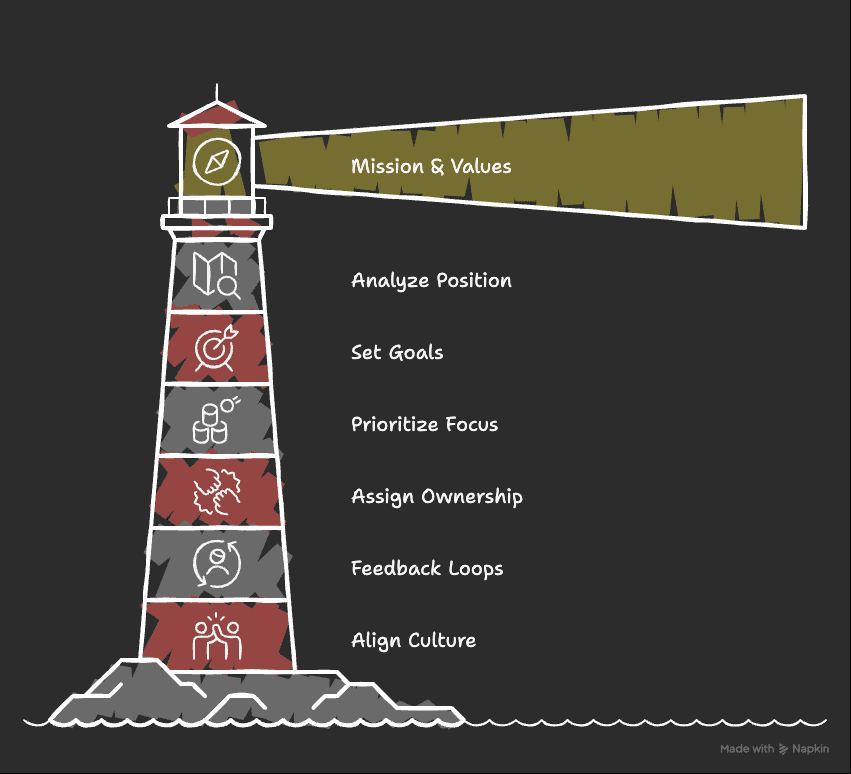Creating a strategic plan is one of the most important things a leadership team can do. And yet, too often, the process is either rushed, bloated, or disconnected from day-to-day execution.
Strategy only works when it’s lived. That starts with clarity—and clarity starts here.
At Champion PSI, we help leadership teams turn good ideas into aligned, measurable outcomes. Coaching and mentoring programs are a powerful lever—especially when they align leadership styles with organizational goals and help leaders adapt to evolving team dynamics. If you’re gearing up for a planning session, this breakdown of executive coaching support might be a useful next step.
Why Creating a Strategic Plan Still Matters

Creating a strategic plan gives your team a common lens—a way to see the future and act on it together. CEO checklist questions help leaders pressure-test their thinking and focus their teams. It’s how vision turns into velocity. Without it? You’re left reacting to problems instead of driving meaningful growth.
But a good plan isn’t just about setting goals. It’s about building the right structure so execution becomes inevitable.
Here are the 7 steps every leader must get right:
- Clarify your mission, vision, and values
- Analyze your current position with real data
- Set specific, measurable, time-bound goals
- Prioritize ruthlessly to focus on what matters most
- Assign real ownership and accountability
- Build in feedback loops and regular reviews
- Align your culture to support the strategy
Each of these sounds simple on the surface—but most leadership teams get at least one wrong. And that’s enough to slow everything down.
1. Clarify Your Mission, Vision, and Values
No amount of planning works without a clear foundation.
- Mission: Why do we exist?
- Vision: Where are we going?
- Values: How do we show up?
These aren’t filler—they guide every trade-off and decision. Great leaders tap into their power by creating a strategic plan that is aligned. Here are a few helpful strategy planning tools to support the process.
2. Analyze Your Current Position With Real Data
Before setting goals, get clear on your actual starting point:
- Strengths and weaknesses (internal)
- Opportunities and threats (external)
- Competitive position
- Market shifts
This is where clarity begins. Skipping it leads to goals that sound good in theory but fall apart in practice. To avoid the common traps, this post on scaling challenges solutions can help.
Leadership style insights from Gallup also help clarify what kind of leadership is best suited to current conditions and team strengths.
3. Set Specific, Measurable, Time-Bound Goals
“Grow revenue” is not a plan.
Instead, anchor each objective to a specific metric, timeline, and department owner. For example:
Increase enterprise pipeline by 25% by Q3 through outbound efforts.
This creates momentum, ownership, and visibility. Without it, execution gets fuzzy.
Leadership trends 2024 include a stronger focus on emotional intelligence and purpose-driven metrics. And solid leadership development principles help reinforce those goals inside real team structures.
4. Prioritize Ruthlessly to Focus on What Matters Most
You can’t do everything—and trying to will stretch your team thin.
Use planning time to make the hard calls:
- What do we say no to?
- What gets our best resources?
- What will move the needle most?
This is also the moment to avoid known execution mistakes that dilute team energy and slow execution. Keep your plan focused, then build momentum from there.
5. Assign Real Ownership and Accountability
For each strategic priority, ask one question: who’s responsible?
Not a team. Not a department. A person.
Each priority should have:
- One clear owner
- A clear definition of success
- Check-in points tied to timelines
Clarity here prevents things from falling through the cracks.
6. Build in Feedback Loops and Regular Reviews
Plans that sit in drawers don’t work. Create regular moments to step back and ask:
- Are we on track?
- What’s changed?
- What do we need to adjust?
Whether it’s quarterly OKRs or monthly leadership syncs, creating a strategic plan enables teams to stay on track as they evolve.
7. Align Your Culture to Support the Strategy
Even the best strategy won’t land in a culture that resists it.
Ask yourself:
- Does this plan reward the behaviors we want?
- Do our systems, incentives, and communication reflect what we say matters?
Deloitte’s research on human performance trends shows that when psychological safety and team trust rise, execution improves dramatically. Here are some culture alignment tools that can help your plan actually stick.
Real-World Example: Adobe’s Strategic Pivot to the Cloud
When Adobe transitioned from selling boxed software to a cloud-based subscription model (Creative Cloud), it wasn’t just a product decision—it was a full strategic overhaul.
They clarified their long-term vision, gathered market data, prioritized key initiatives, and prepared their teams to adapt. According to Harvard Business Review, this shift doubled their recurring revenue and turned Adobe into a model for digital transformation.
That’s what happens when creating a strategic plan isn’t just an annual exercise—it’s a leadership habit.
FAQs About Creating a Strategic Plan
What is the first step in creating a strategic plan?
Start by anchoring everything in your mission, vision, and values. These aren’t just brand statements—they shape how your leadership team makes decisions, prioritizes resources, and communicates across the company. Without this foundation, strategy becomes guesswork.
How long should a strategic plan last?
Most strategic plans span 1 to 3 years, depending on the pace of your industry and the size of your organization. That said, the best plans are reviewed quarterly and remain flexible. You don’t need to rewrite the playbook every few months—but you do need to revisit it and adapt based on what’s changed.
Who should be involved in strategic planning?
Start with your senior leadership team. But to truly execute, bring in key contributors from operations, sales, marketing, and finance. Involving diverse perspectives early leads to stronger buy-in later—and avoids the classic “leadership bubble” effect where a plan sounds good in theory but doesn’t work in practice.
How often should a strategic plan be updated?
Quarterly check-ins are ideal. They let you recalibrate without overhauling. Annual reviews are the bare minimum. The real goal is to treat strategy as a living system—something that evolves with your business, not something that collects dust in a Google Drive folder.
What’s the difference between a business plan and a strategic plan?
A business plan is about how you operate. A strategic plan is about where you’re going and how you’ll win. Business plans are often static documents for investors. Strategic plans are execution blueprints—they’re what your leadership team uses to align, prioritize, and move fast with confidence.
Creating a Strategic Plan: 7 Steps Leaders Must Get Right – Conclusion
Creating a strategic plan is about more than setting goals. It’s about creating clarity, alignment, and momentum—so your team knows exactly what to do and why it matters.
Don’t wait until the next offsite to get started. The best leaders build strategy into how they operate…not just how they plan.
Ready to get started? Book a free 30-minute call with an expert coach to explore how creating a strategic plan can support your goals.










